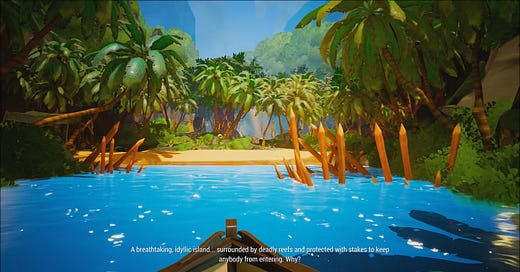If you didn’t catch last week’s Saturshot, I raised the idea of also writing about things that interest me, but don’t reflect wholly positively on the game in question. Nobody objected, so here goes!
Call of the Sea is an adventure game that sees you play as Norah, a woman following after her husband who went missing on a research trip in the South Pacific. Its island setting is very pretty, and each story chapter relies on you exploring your environment and solving large scale puzzles to progress.
Despite its environmental-based gameplay, Norah delivers a large amount of exposition, frequently and in detail. When you first arrive at the island, she points out the (highly visible) spikes discouraging entrance. She immediately follows up with the thought that there’s “definitely something strange about this island”.
Rather than introducing anything new or reflective, Norah’s comments are almost always self-evidential. She points out a nearby camp, and says it must have belonged to her husband (you know, her missing husband, the one she’s looking for). Explanations like this fire off with little downtime in between, and I found myself doing the cognitive equivalent of relaxing my gaze. I thought, if this game wants to tell me exactly what it is, rather than let me wonder, then I don’t have to try very hard to notice things.
Then, of course, the first real puzzle stumped me. I walked round and round in irritated circles, because while it wasn’t needlessly difficult, I was sure it had to be much simpler than it actually was. When I did start paying more attention, Norah’s narration then became the source of irritation, because I’d already noticed the things she was telling me.
Characters thinking aloud (and especially describing things) is almost a defining trope of adventure games, but the implementation matters. Away from the constraints of 2D pixel art, there’s less of a need to tell the player what they’re looking at. For Call of the Sea, Norah’s frequent interjections that explicitly explained what the visual design implied primed me to not look deeper. So when I needed to look to that design to interact with the core gameplay, this created a problem.
Oh, Also
Good Games Writing have been announcing their Goodies awards this week! While I’m very pleased to have been nominated for the accessibility & inclusion award for my piece on Hades, I thoroughly encourage you to check out all the awards and nominees. They’ve been highlighting the kinds of coverage that often get overlooked, like mobile gaming and guides, in addition to really great criticism and reporting. Check it out!
Ruth Cassidy is a writer and self-described velcro cyborg who, when not writing about video games, is probably being emotional about musicals, mountains, or cats. Has had some bylines, in some places.
Reading this online? You can subscribe to Saturshot for bitesize games criticism in your inbox every Saturday!





